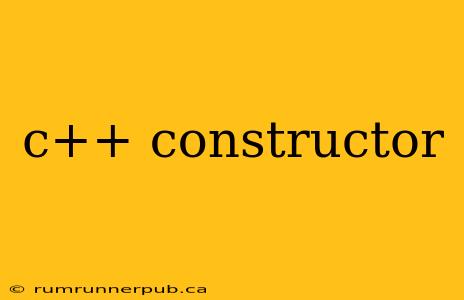Constructors are fundamental to object-oriented programming in C++, acting as the initialization blueprints for your classes. They're called automatically when you create an object, ensuring that your objects are properly set up before they're used. This article will explore C++ constructors, drawing insights from Stack Overflow discussions to provide a comprehensive understanding.
What is a Constructor?
Simply put, a constructor is a special member function of a class that has the same name as the class itself. It's automatically invoked when an object of the class is created. Its primary role is to initialize the member variables (data) of the object.
Example (inspired by common Stack Overflow examples):
class Dog {
public:
// Constructor
Dog(std::string name, std::string breed) : name_(name), breed_(breed) {
std::cout << "Dog " << name_ << " created!\n";
}
void bark() {
std::cout << "Woof!\n";
}
private:
std::string name_;
std::string breed_;
};
int main() {
Dog myDog("Buddy", "Golden Retriever"); // Constructor called automatically here
myDog.bark();
return 0;
}
In this example, the Dog constructor takes the dog's name and breed as arguments and initializes the private member variables name_ and breed_. The : name_(name), breed_(breed) part is called a member initializer list, a crucial technique for efficient and safe initialization, often highlighted in Stack Overflow answers related to constructor performance. Using a member initializer list is generally preferred over assigning values within the constructor body, as it avoids unnecessary default construction and assignment.
Different Types of Constructors
C++ offers several types of constructors, each serving a specific purpose:
1. Default Constructor: A constructor that takes no arguments. If you don't define any constructor, the compiler provides a default constructor (unless you have other constructors or member variables requiring explicit initialization).
2. Parameterized Constructor: A constructor that takes arguments, allowing you to initialize the object with specific values. This is demonstrated in the Dog example above.
3. Copy Constructor: A constructor that takes an object of the same class as an argument. It's used to create a copy of an existing object. Understanding copy constructors is crucial to avoid issues like shallow copies and dangling pointers, frequently discussed on Stack Overflow.
Dog anotherDog(myDog); // Copy constructor called here
4. Move Constructor (C++11 and later): A constructor that takes an rvalue reference (an object that is about to be destroyed) as an argument. This allows for efficient resource transfer without unnecessary copying, vital for performance optimization, a topic often raised in Stack Overflow questions.
5. Constructor with Default Arguments: This allows you to provide default values for parameters, making your constructor more flexible.
Common Constructor-Related Stack Overflow Questions and Answers (Paraphrased and Expanded)
Q: Why is my default constructor not being called? (Common Stack Overflow theme)
A: If you define any other constructor, the compiler will not automatically generate a default constructor. You'll need to explicitly define it if you want the ability to create objects without providing any arguments. Failing to do so might lead to compilation errors when trying to create objects without arguments.
Q: How to handle potential errors during constructor initialization? (Frequently asked)
A: While constructors are primarily designed for initialization, error handling is equally important. Use exceptions to gracefully handle situations where initialization fails. If an error occurs during initialization, throw an exception to signal failure. This makes error detection much easier. For example:
class Resource {
public:
Resource(const std::string& filename) {
// Try to open file.
file_.open(filename);
if (!file_.is_open()) {
throw std::runtime_error("Could not open file: " + filename);
}
}
private:
std::fstream file_;
};
Q: What's the difference between member initializer lists and assignment within the constructor body? (A key Stack Overflow distinction)
A: Member initializer lists are generally preferred for their efficiency and proper initialization of const and reference members. They directly initialize member variables, avoiding unnecessary default construction and assignment. Assignment in the constructor body performs those operations, leading to a less efficient implementation.
Conclusion
Understanding C++ constructors is essential for writing robust and efficient code. By mastering different constructor types, utilizing member initializer lists effectively, and implementing appropriate error handling, you can create well-structured classes and manage resources effectively. This article, building upon the collective knowledge from countless Stack Overflow threads, aims to provide a clear and comprehensive guide to this crucial aspect of C++ programming. Remember to consult the C++ standard and relevant documentation for the most up-to-date and accurate information.
